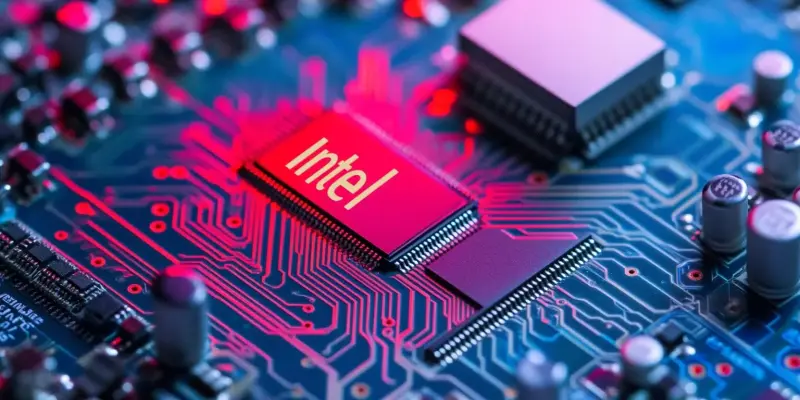The telecommunications industry is undergoing a significant transformation, driven by the advent of AI and 5G technologies. Central to this evolution is Intel’s new Xeon 6 “Granite Rapids” server CPUs, which are designed to enhance network infrastructure and connectivity. These processors are setting new standards in performance and efficiency, thanks to their integrated AI acceleration and advanced features tailored for network and edge applications. The latest generation of Intel’s server processors promises to revolutionize the way telecom networks operate, merging cutting-edge technology with unparalleled performance metrics.
Network Transformation and AI Acceleration
The introduction of Intel’s Xeon 6 SoC marks a pivotal moment for telecom networks, particularly in terms of AI acceleration. With integrated AI features like Intel Advanced Vector Extensions (AVX) and Intel Advanced Matrix Extensions (AMX), the Xeon 6 processors deliver up to 3.2 times better AI RAN performance compared to previous generations. This advancement eliminates the need for discrete accelerators, streamlining network operations and boosting efficiency. These AI capabilities are essential for deploying 5G technologies, which demand robust and efficient network infrastructures. The Xeon 6 CPUs meet these demands, equipping telecom operators with the tools needed to enhance connectivity and performance across their networks.
These AI-enhanced processors are more than just an incremental upgrade; they represent a shift in how telecom networks are designed and operated. By integrating AI directly into the CPU, Intel has created a solution that not only improves raw performance but also reduces complexity and cost. The AI capabilities ensure that networks can manage more data and perform complex tasks more efficiently, which is crucial as the volume of data transmitted across networks continues to grow exponentially. As telecom operators integrate Intel Xeon 6 processors into their infrastructure, the benefits of AI acceleration become increasingly apparent, offering a glimpse into the future of telecommunications.
Efficiency and Capacity
One of the standout features of the Intel Xeon 6 SoC is its ability to significantly reduce server footprints while increasing capacity. With eight integrated Ethernet ports offering up to 200 Gbps of throughput, the processors ensure robust connectivity and high performance. This optimized architecture allows telecom operators to consolidate multi-server open vRAN sites into a single-server footprint, reducing total cost of ownership (TCO) and improving overall efficiency. The scalability offered by these processors makes it easier for telecom companies to expand their networks without incurring prohibitive costs, streamlining both operational and capital expenditures.
The inclusion of the Intel Media Transcode Accelerator offers a remarkable performance-per-watt gain of up to 14.25 times for video transcoding. This feature is particularly beneficial for applications requiring near-real-time experiences, such as live sports, gaming, and auctions, while also reducing power consumption. The ability to handle such demanding tasks with reduced power requirements highlights the processors’ efficiency, supporting the growing need for high-quality streaming services without overburdening the network. By enabling more efficient video processing, Intel Xeon 6 processors can maintain higher levels of service quality even during peak usage periods, ensuring a seamless user experience.
Security
As data generation at the network edge continues to grow, security becomes increasingly important. The Intel Xeon 6 SoC addresses these concerns with advanced security features that support more secure, zero-trust connections across the edge-to-cloud ecosystem. This focus on security ensures that telecom networks can handle the growing volume of data while maintaining data integrity and secure connections. The enhanced security capabilities are crucial for modern networks, which must protect sensitive information and maintain trust with users, especially as cyber threats become more sophisticated.
The advanced security features embedded in Xeon 6 processors ensure that operators can implement more comprehensive security measures without significant performance drawbacks. This includes capabilities like secure boot, runtime encryption, and threat detection, all of which contribute to a more resilient network infrastructure. By integrating security features at the hardware level, Intel has provided a more robust foundation for telecom networks, reducing vulnerabilities that could be exploited by malicious actors. Telecom operators can confidently invest in Xeon 6 processors, knowing that their infrastructure will be more secure and capable of defending against increasingly complex threats.
Adoption by Leading Telecom Operators
Leading telecom operators such as Vodafone, AT&T, Samsung, and Verizon are at the forefront of adopting Intel’s Xeon 6 processors. These operators are leveraging the enhanced performance, energy efficiency, and infrastructure optimization offered by the new CPUs to transform their networks. For instance, Vodafone’s OpenRAN deployments highlight the competitiveness of networks built on Intel Xeon versus legacy RAN technologies. This adoption demonstrates the broad appeal of the Xeon 6 processors and underscores their potential to drive significant improvements in telecom infrastructure.
AT&T’s collaboration with Ericsson and Intel to develop a leading RAN network using the Xeon 6 SoC exemplifies the industry’s commitment to innovation. Similarly, Verizon is advancing its 5G RAN footprint with virtualization, doubling RAN compute capacity, enhancing energy efficiency, and supporting multitasking. These pioneering efforts underscore the widespread industry support for Intel’s advancements, showcasing how leading telecom operators are capitalizing on the new technologies to enhance their services. As more operators follow suit, the transformative impact of Intel’s Xeon 6 CPUs on the telecom industry will become increasingly evident.
Sustainability
The telecommunications sector is experiencing a profound shift brought about by the rise of AI and 5G technologies. At the heart of this transformation are Intel’s new Xeon 6 “Granite Rapids” server CPUs, which are engineered to enhance network infrastructure and connectivity. These processors are elevating performance and efficiency standards, boasting integrated AI acceleration and advanced features specifically designed for network and edge applications. Intel’s latest generation of server processors is set to revolutionize telecom network operations, blending state-of-the-art technology with unmatched performance metrics. This innovation paves the way for more robust and responsive networks, facilitating the deployment of smarter, more efficient telecommunication systems. As the industry evolves, Intel’s cutting-edge processors will play a crucial role in shaping the future of global connectivity, ensuring that networks are not only faster but also more intelligent and adaptable to the growing demands of users worldwide.

